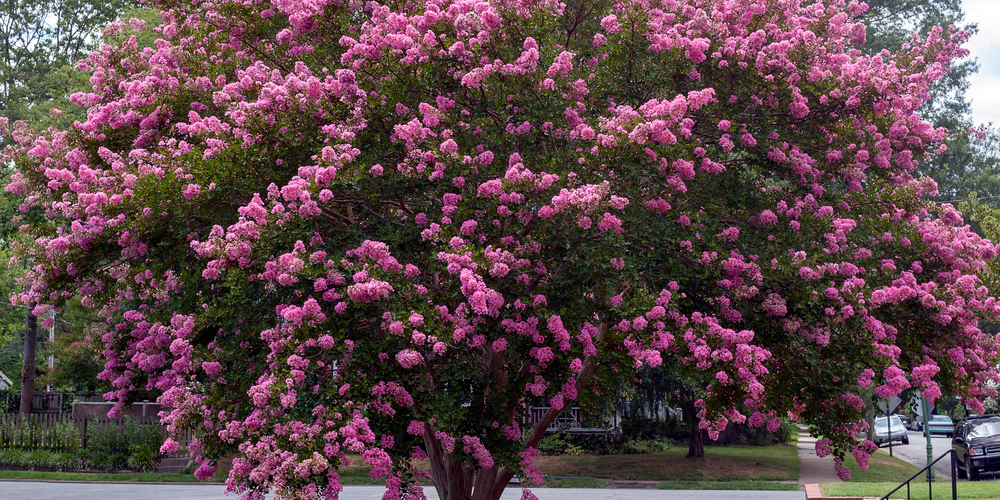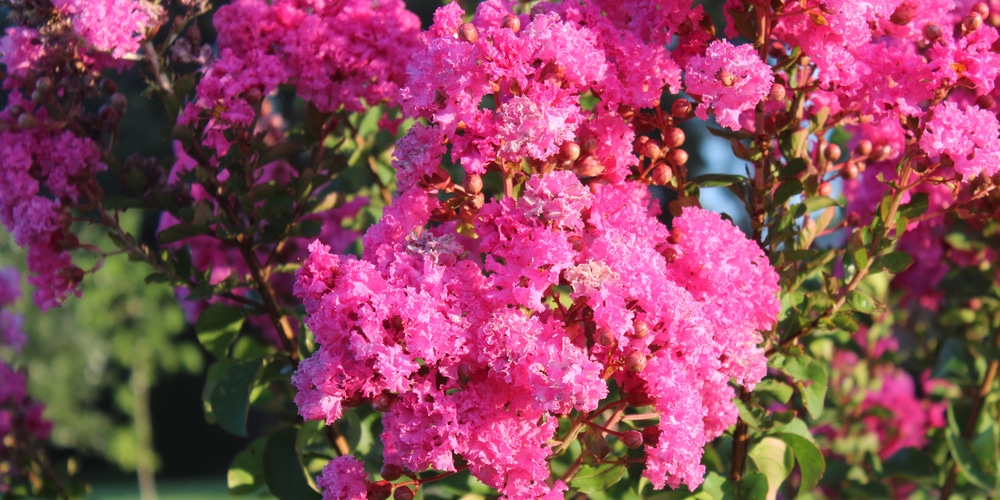The Crepe Myrtle is a beautiful flowering tree that is native to Asia. It is extensively grown in the southern United States and is a widely used ornamental tree.
The crepe myrtle blooms in colors such as white, pink, lavender, and red; their flowers are very beautiful. The main attraction of this tree is its colorful flowers and excellent fall foliage. The leaves of the crepe myrtle turn yellow, orange, and red in fall, adding to the beauty of this tree.
Pruning is essential to maintain the aesthetic value and health of the crepe myrtle. Many people do not know how to correctly prune a crepe myrtle which often results in misshapen trees.
This guide will provide you with all the information you need on the correct way to prune crepe myrtles and the tools you will need.
Is Pruning Advisable For Crepe Myrtle?

Many gardeners have heard that pruning crepe myrtle is advisable, but they may not know why.
First and foremost, pruning helps to encourage new growth. By removing older, woody branches, gardeners can encourage the crepe myrtle to produce new shoots.
In addition, pruning can help improve the plant’s overall shape and appearance. By selectively removing certain branches, gardeners can create a more aesthetically pleasing plant.
Finally, pruning can help to control the plant’s size. By trimming back excess growth, gardeners can keep the crepe myrtle from becoming too large for its space.
As a result, pruning is essential to keeping a healthy and attractive crepe myrtle.
Is There A Wrong Way To Prune Crepe Myrtle?
Prune crepe myrtle the wrong way, and you’ll end up with a big, ugly bush. Crepe myrtles are meant to be enjoyed for their beautiful, multi-stemmed trunks and delicate flowers.
But all too often, people hack them back into giant spheres or shear them into boxy shapes. This not only ruins their aesthetic appeal but can also lead to excessive growth and disease problems. This is often referred to as “Crepe Murder.”
So how should you prune your crepe myrtle?
The Correct Way To Prune Crepe Myrtle
Pruning Tools
Any gardener will tell you that the right tools can make all the difference in pruning. And that’s certainly true when it comes to crepe myrtle.
This elegant flowering tree is a favorite of gardeners in the southern United States, where it blooms prolifically during the summer months. But crepe myrtle can be a bit finicky when it comes to pruning, and using the wrong tools can damage the bark or even kill the tree.
So what are the best tools for pruning crepe myrtle?
A pair of hand pruners or loppers for small branches will do the job nicely. For larger branches, a pruning saw is a better choice. And for huge branches, you’ll need a chainsaw.
But regardless of which tool you use, always ensure that the blades are sharp – dull blades can crush crepe myrtle bark, causing severe damage to the tree.
How To Prune
Step 1: Start at the bottom-most part of the tree.
Crape myrtle trees can sometimes get too large and unwieldy, with multiple trunks crowding the plant. While it may seem counterintuitive, pruning your crape myrtle can help reduce its size and keep it healthy.
Removing some of the smaller, secondary trunks will encourage the plant to invest its energy in the larger main trunks. This will create a stronger, more structurally sound tree that is less likely to experience problems as it matures.
One of the most important things to consider when pruning crape myrtles is the number of trunks. Choose an odd number of major trunks for most types. A trunk with an odd number of branches is more attractive than one with an even number. When picking trunks, choose ones with plenty of areas to develop and grow straight and strong. After you’ve picked the correct number of trunks, snip any competing branches away.
Trimming back stems involves cutting all the way down to the soil line. This will prevent you from leaving a dead stub, which does not look good and vulnerable to insect and disease penetration. Furthermore, as near to the dirt line as feasible, prune suckers and any extra trunks.
It is advisable to prune low branches (those below eye level) every year to allow for easy mowing and prevent the formation of a dense understory.
Step 2: Complete with the top-most part of the tree.
The top branches should ideally spread out in various directions, so any branches that are growing into an area already covered by another branch should be removed. Furthermore, any branches that cross back over the plant or rub against one another should also be removed. These branches can get wounded by wind movement and growth and eventually one or both of them will perish.
To allow better air circulation and sunlight penetration, which will reduce the potential for diseases like powdery mildew, remove excess branches in the plant’s interior.
For the final section, you’ll need to remove branches or stems that are thinner than a pencil. If you allow wood this small on the tree, it will result in weak new growth that won’t be able to support any blossoms. Not only will this affect the look of your tree, but it may also cause long-term damage.
When To Prune
Pruning For Maintenance
Pruning is a critical part of tree care, but it’s essential to know when to prune your crepe myrtle. Pruning at the wrong time of year can damage the tree or encourage unwanted growth.
The best time to prune crepe myrtles for maintenance is in the late winter or early spring when the tree is dormant. This is the ideal time to prune if you are trying to shape the tree, remove weak or damaged branches, encourage new growth, or maintain its size.
Pruning To Induce Second Bloom
Crepe myrtle trees are beloved for their beautiful flowers, which bloom in various colors, including pink, white, and purple. Though the blossoms only last for a few weeks, gardeners can encourage their crepe myrtles to produce a second round of flowers through a practice called deadheading.
Deadheading involves removing spent blooms shortly after they fade. This encourages the tree to produce new flowers rather than putting all its energy into seed production. However, it is vital to deadhead crepe myrtles carefully, as pruning too late in the season can delay dormancy and potentially kill the tree over winter.
For best results, deadhead crepe myrtles in early August, before the first frost. This will give the tree enough time to produce another round of blossoms before winter sets in.
Final Thoughts
Pruning is an integral part of tree care, but it’s essential to know when and how to prune your crepe myrtle. Pruning at the wrong time of year can damage the tree or encourage unwanted growth.
When pruning for maintenance, the best time to prune is in the late winter or early spring when the tree is dormant if you are trying to encourage new growth or produce a second round of blossoms, deadhead crepe myrtles in early August, before the first frost.
By following these tips, you can keep your crepe myrtle healthy and looking its best for years to come.

